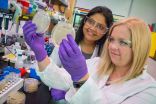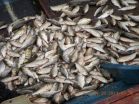How corals can actually benefit from climate change effects
Ocean acidification can enhance growth rates of some reef-forming corals
2014-11-05
(Press-News.org) Researchers from Northeastern University's Marine Science Center and the University of North Carolina at Chapel Hill have found that moderate ocean acidification and warming can actually enhance the growth rate of one reef-building coral species. Only under extreme acidification and thermal conditions did calcification decline.
Their work, which was published Wednesday in the journal Proceedings of the Royal Society B: Biological Sciences, is the first to show that some corals may benefit from moderate ocean acidification.
Justin Ries, an associate professor at Northeastern and one of the paper's co-authors, focuses his research on the biological impacts of rising atmospheric carbon dioxide levels, which has been increasing ocean acidity since the Industrial Revolution. One group of organisms that would be greatly affected by ocean acidification are those that build calcium carbonate shells and skeletons, such as coral, snails, and clams, which, he said, are already near the point of dissolving in some parts of the ocean.
The authors attribute the coral's positive response to moderately elevated carbon dioxide to the fertilization of photosynthesis within the coral's algal symbionts, which may provide the coral with more energy for calcification even though the seawater is more acidic. They propose that the eventual decline in coral calcification at the very high levels of carbon dioxide occurs when the beneficial effects of fertilizing photosynthesis are outweighed by the negative effects of acidification on the skeleton-forming process.
"The study showed that this species of coral (Siderastrea siderea) exhibited a peaked or parabolic response to both warming and acidification, that is, moderate acidification and warming actually enhanced coral calcification, with only extreme warming and acidification negatively impacting the corals," Ries said. "This was surprising given that most studies have shown that corals exhibit a more negative response to even moderate acidification."
Furthermore, their work indicates that ocean warming is likely to threaten this coral species more than acidification by the end of the century, based on projections from the Intergovernmental Panel on Climate Change.
He noted that in the past 200 years, ocean pH level has dropped from 8.2 to 8.1 and is expected to fall even further to about 7.8 over the next one or two centuries. That is a significant decrease over a relatively short period of time, Ries said, when looking at the geologic history of ocean acidification.
"The amount of change that would typically occur in about 10 million years is being condensed into a 300-year period," Ries said. "It's not the just the magnitude of the change that matters to the organisms, but how quickly it is occurring."
In addition to publishing these findings, Ries has leveraged his research in this area to secure a prestigious fellowship from the Hanse Wissenschaftskolleg Institute for Advanced Study in Delmenhorst, Germany and a supporting research award from the National Science Foundation. He will spend 10 months over the next four years there working with researchers at three prominent German research institutions to use various tools such as microelectrodes, isotope ratios, and pH sensitive dyes to see how ocean acidification affects the organisms' internal calcifying processes that lead to the formation of their shells and skeletons.
"Acidification of the surrounding seawater is certainly important for marine organisms, but what is equally as important — perhaps even more important — is how the chemistry of their internal calcifying fluid responds to these changes in seawater chemistry," Ries said.
INFORMATION:
[Attachments] See images for this press release:

ELSE PRESS RELEASES FROM THIS DATE:
2014-11-05
WASHINGTON, DC—November 4, 2014—An international team of bioengineers has boosted the ability of bacteria to produce isopentenol, a compound with desirable gasoline properties. The finding, published in mBio®, the online open-access journal of the American Society for Microbiology, is a significant step toward developing a bacterial strain that can yield industrial quantities of renewable bio-gasoline.
The metabolic engineering steps to produce short-chain alcohol solvents like isopentenol in the laboratory bacteria Escherichia coli have been worked on ...
2014-11-05
From water marks to colored threads, governments are constantly adding new features to paper money to stay one step ahead of counterfeiters. Now a longhorn beetle has inspired yet another way to foil cash fraud, as well as to produce colorful, changing billboards and art displays. In the journal ACS Nano, researchers report a new kind of ink that mimics the beetle's color-shifting ability in a way that would be long-lasting and difficult to copy.
Zhongze Gu, Zhuoying Xie, Chunwei Yuan and colleagues explain that some U.S. bills have color-changing features to help thwart ...
2014-11-05
Researchers from MIPT and the Weizmann Institute of Science (Israel) have predicted the possibility of negative turbophoresis, a phenomenon where impurity particles inside a turbulent flow move in an "impossible" direction. The study by Sergei Belan (a postgraduate at MIPT), Grigory Falkovich and Itzhak Fouxon was published in the journal Physical Review Letters in the Editors' Suggestions section, which features the most important and interesting studies from the editorial board's point of view.
The researchers studied the behavior of inertial particles in different ...
2014-11-05
An international study has devised a new measure for the "livability" of major cities across the world. The Global Liveable Cities Index (GLCI) takes into account the sensibilities of ordinary working people from 64 cities, balancing work and play, environmental awareness, localism, globalism and many other factors. Details are published in the World Review of Science, Technology and Sustainable Development.
According to Tan Khee Giap of the National University of Singapore and colleagues at University of California, Davis, and Curtin University, in Bentley, Australia, ...
2014-11-05
In a recent paper published in Nature Nanotechnology, Joel Moser and ICFO colleagues of the NanoOptoMechanics research group led by Prof. Adrian Bachtold, together with Marc Dykman (Michigan University), report on an experiment in which a carbon nanotube mechanical resonator exhibits quality factors of up to 5 million, 30 times better than the best quality factors measured in nanotubes to date.
Imagine that the host of a dinner party tries to get his guests' attention by giving a single tap of his oyster spoon on his crystal glass. Now, imagine, to the amazement of all, ...
2014-11-05
New Danish-led research suggests that signs of brain aging can be postponed in mice if placed on a high-fat diet. In the long term, this opens the possibility of treatment of children suffering from premature aging and patients with Alzheimer's and Parkinson's disease. The research project is headed by the Center for Healthy Aging, University of Copenhagen and the National Institute of Health.
When we get older, defects begin to develop in our nervous system, our brain loses some of its intellectual capacity, and the risk of developing diseases such as Parkinson's and ...
2014-11-05
Using DESY's ultrabright X-ray source PETRA III, researchers have observed in real-time how football-shaped carbon molecules arrange themselves into ultra-smooth layers. Together with theoretical simulations, the investigation reveals the fundamentals of this growth process for the first time in detail, as the team around Sebastian Bommel (DESY and Humboldt Universität zu Berlin) and Nicola Kleppmann (Technische Universität Berlin) reports in the scientific journal Nature Communications. This knowledge will eventually enable scientists to tailor nanostructures ...
2014-11-05
Researchers at the Cognition and Brain Plasticity group of the Bellvitge Biomedical Research Institute (IDIBELL) and the University of Barcelona have been tracking the traces of implicit and explicit memories of fear in human. The study has been published in the journal Neurobiology of Learning and Memory and describes how in a context of fear, our brain differently encodes contextual memory of a negative event (the place, what we saw...) and emotional response associated.
The study measures electrodermal activity of 86 individuals in a fearful generated in the laboratory ...
2014-11-05
Bethesda, MD (Nov. 5, 2014) — Up to 15 percent of the general adult population is affected by irritable bowel syndrome (IBS), and most patients struggle to find effective drug therapy. A new guideline from the American Gastroenterological Association (AGA) provides these patients and their physician's guidance. The new guideline and accompanying technical review have been published in Gastroenterology, the official journal of the AGA Institute.
"Because no IBS therapy is uniformly effective, many patients describe a history of a variety of treatments alone or in ...
2014-11-05
What sounds counter-intuitive to an activity commonly perceived as quiet is the broad recommendation of scientists at Michigan State University (MSU) recommending that small-scale fishing in the world's freshwater bodies must have a higher profile to best protect global food security.
In this month's journal Global Food Security, scientists note that competition for freshwater is ratcheting up all over the world for municipal use, hydropower, industry, commercial development, and irrigation. Rivers are being dammed and rerouted, lakes and wetlands are being drained, fish ...
LAST 30 PRESS RELEASES:
[Press-News.org] How corals can actually benefit from climate change effects
Ocean acidification can enhance growth rates of some reef-forming corals






